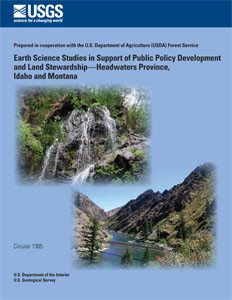
Product Details
- Product Number
- 243066
- Series
- CIR-1363
- Scale
- NO SCALE
- Alternate ID
- 21-1363
- ISBN
- 978-1-4113-3023-8
- Authors
- ALAN R WALLACE
- Version Date
- 01/01/2010
- Countries
- USA
- Media
- Paper
- Format
- Bound
Additional Details
- Description
- Minerals in the environment and products manufactured from mineral materials are all around us and we use and come into contact with them every day. They impact our way of life and the health of all that lives. Minerals are critical to the Nation#s economy and knowing where future mineral resources will come from is important for sustaining the Nation#s economy and national security. The U.S. Geological Survey (USGS) Mineral Resources Program (MRP) provides scientific information for objective resource assessments and unbiased research results on mineral resource potential, production and consumption statistics, as well as environmental consequences of mining. The MRP conducts this research to provide information needed for land planners and decisionmakers about where mineral commodities are known and suspected in the earth#s crust and about the environmental consequences of extracting those commodities. As part of the MRP scientists of the Western Mineral and Environmental Resources Science Center (WMERSC or #Center# herein) coordinate the development of national, geologic, geochemical, geophysical, and mineral-resource databases and the migration of existing databases to standard models and formats that are available to both internal and external users. The unique expertise developed by Center scientists over many decades in response to mineral-resource-related issues is now in great demand to support applications such as public health research and remediation of environmental hazards that result from mining and mining-related activities. Western Mineral and Environmental Resources Science Center Results of WMERSC research provide timely and unbiased analyses of minerals and inorganic materials to (1) improve stewardship of public lands and resources; (2) support national and international economic and security policies; (3) sustain prosperity and improve our quality of life; and (4) protect and improve public health, safety, and environmental quality. The MRP supports approximately 40 USGS research specialists who utilize cooperative agreements with universities, industry, and other governmental agencies to support their collaborative research and information exchange. Scientists of the WMERSC study how and where non-fuel mineral resources form and are concentrated in the earth#s crust, where mineral resources might be found in the future, and how mineral materials interact with the environment to affect human and ecosystem health. Natural systems (ecosystems) are complex#our understanding of how ecosystems operate requires collecting and synthesizing large amounts of geologic, geochemical, biologic, hydrologic, and meteorological information. Scientists in the Center strive to understand the interplay of various processes and how they affect the structure, composition, and health of ecosystems. Such understanding, which is then summarized in publicly available reports, is used to address and solve a wide variety of issues that are important to society and the economy. WMERSC scientists have extensive national and international experience in these scientific specialties and capabilities#they have collaborated with many Federal, State, and local agencies; with various private sector organizations; as well as with foreign countries and organizations. Nearly every scientific and societal challenge requires a different combination of scientific skills and capabilities. With their breadth of scientific specialties and capabilities, the scientists of the WMERSC can provide scientifically sound approaches to a wide range of societal challenges and issues. The following sections describe examples of important issues that have been addressed by scientists in the Center, the methods employed, and the relevant conclusions. New directions are inevitable as societal needs change over time. Scientists of the WMERSC have a diverse set of skills and capabilities and are proficient in the collection and integration of new and existing data and in the use of those data to arrive at scientifically sound conclusions. Scientific specialties and capabilities include, but they are not limited to: Economic geology and petrology#understanding ore-forming processes and the controls that affect the distribution of ore deposits to develop descriptive, genetic, as well as grade and tonnage mineral-deposit models Geochemistry and biogeochemistry#determining distributions of elements, particularly metals and metalloids, in rock, water, soil, and vegetation and defining the processes that affect their concentration, transport, and fate in natural systems Geophysics#determining and interpreting gravity, magnetic, electromagnetic, and seismic signatures of geologic settings to identify subsurface features and processes Remote sensing#determining surface geology, subsurface geologic structure, hydrology, vegetation and other land cover for large, inaccessible areas Integrated geologic analysis#determining geologic, structural, and tectonic history; hydrologic setting of geologically complex areas; as well as ongoing natural processes that affect these areas Mineral-resource assessments#conducting research on new methods to evaluate resource potential, analyzing economics of mineral commodities, understanding the geologic history and characteristics of an area, defining what processes formed the mineral deposits, and identifying keys to predicting undiscovered deposits Integrated ecosystem analysis#determining the relationships between geologic environments and habitat conditions and health, including human health, particularly in mineralized settings Geographic information system skills#compiling, numerically modeling, and analyzing complex geoscience data
- Survey Date
- 2010
- Print Date
- 2010
- Height In Inches
- 11.000
- Width In Inches
- 0.200
- Length In Inches
- 8.500
- Two Sided
- Yes
- Pieces
- 1
- Languages
- English
Related Items



